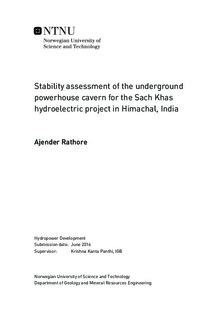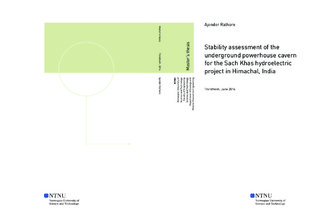| dc.description.abstract | Chenab basin in state of Himachal Pradesh has been opened for detailed study and development of hydropower projects. The government of Himachal Pradesh awarded development of the 260+7 MW Sach Khas project to L&T Himachal Hydropower Limited (L&T HHL) on competitive bidding to develop the project on Build, Own, Operate and Transfer (BOOT) basis. It is a dam toe project with underground power house. This work aims to access placement, optimize orientation and perform stability assessment of caverns placed close to toe slope of the valley. To achieve this objective, engineering geological conditions including rock mass properties and stress situation in the Sach Khas project area have been evaluated.
Original placement and orientation of the caverns from the background information is assessed. In addition, an alternative orientation is proposed to reduce the length of the appurtenant tunnel system and minimize the impact of structurally induced instability. The two cases are compared throughout the thesis.
An in-depth stability assessment of the underground caverns is carried out, with scope of evaluating possible structurally induced instability and stress induced instabilities for the caverns. The analysis includes analytical, empirical and numerical methods. The analysis detected low cumulative probability for block fall, brittle failure in the cavern roof and tensile fracturing in the cavern walls extending towards slope face due to magnitude and anisotropy in the redistributed stresses. The stress induced instabilities are more extensive than structurally induced instabilities in both cavern alignments due to its placement, orientation, shape and size.
Probabilistic Unwedge analysis is done to assess the structurally induced stability problems. Analytical and empirical studies involve Kirsch s equations and Hoek and Brown (1980) methods to assess the redistribution and concentration of stresses in the cavern contour. Spalling potential and depth of brittle failure is estimated based on cavern span, rock mass spalling strength and tangential stresses. The results are compared to estimation of failure depth from numerical analysis using analysis of strength factor with Hoek-Brown brittle parameters in 2D finite element program, Phase2. 3D finite element analysis (RS3) is carried out for the final selected cavern alignment. Reasonable difference between analytical/empirical and numerical approach is found considering caverns location in low rock cover and near tow slope.
Support measures are proposed based on empirical relations, recommendations from the RMR, Q-system and analysis of yielding and deformation from the numerical results.
From assessment of engineering geological conditions and in-depth stability analysis, it is considered feasible to obtain a satisfactory level of stability for original alignment, considering the rock mass properties and stress conditions that are most likely to occur. However, the numerical analysis carried out for worst case scenario showed significant stability problems. If such conditions prevail in the area, placing large scale cavern may be challenging regarding stability during construction and long term stability aspects. | |

